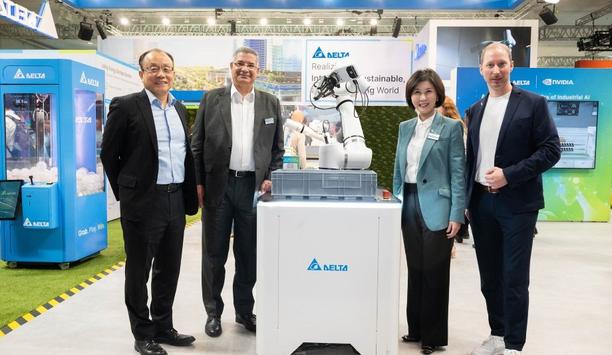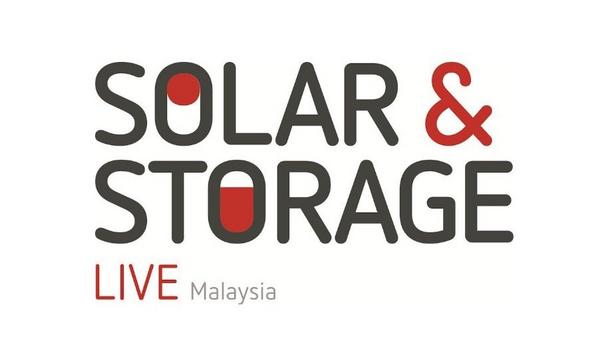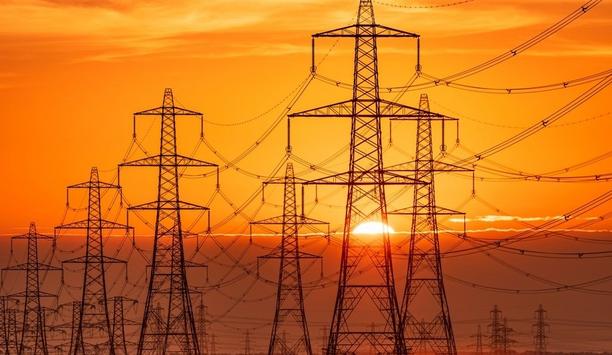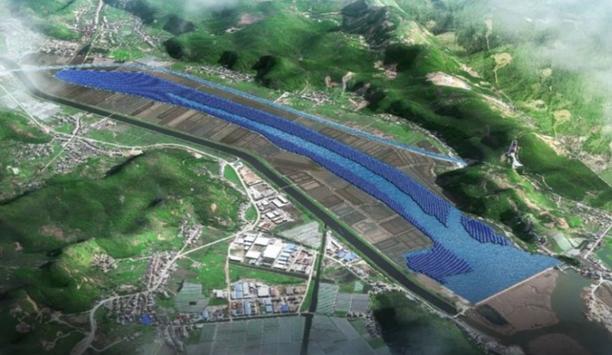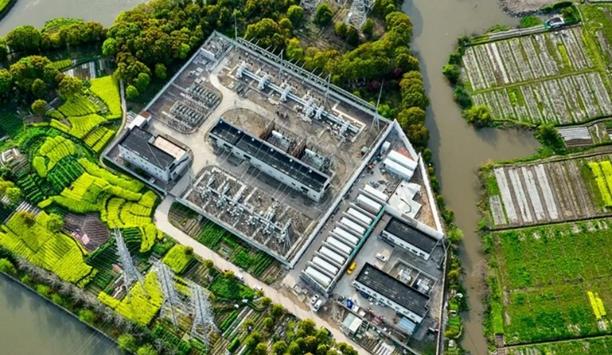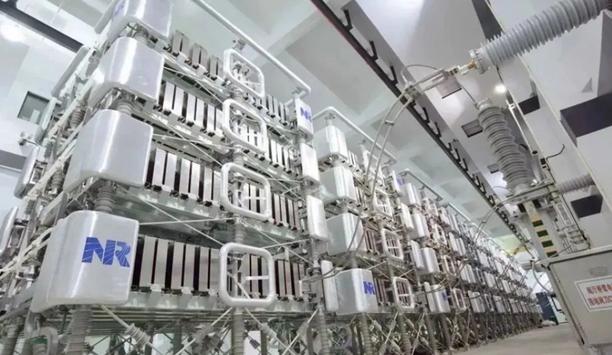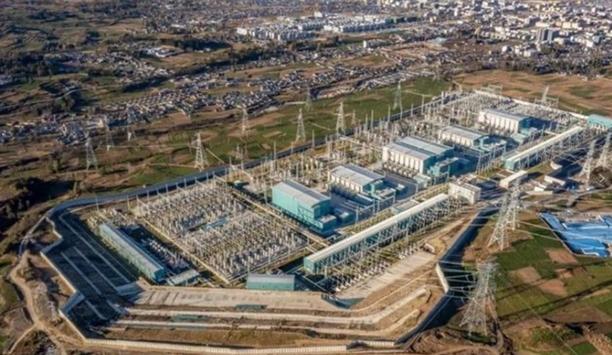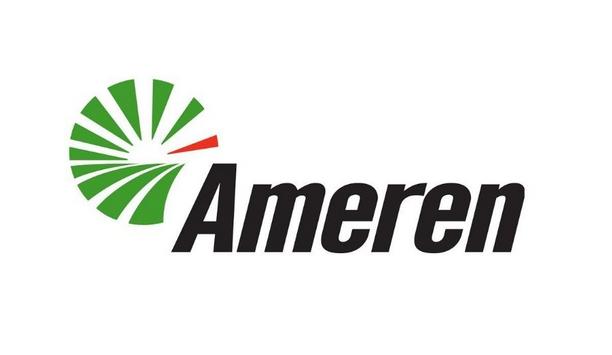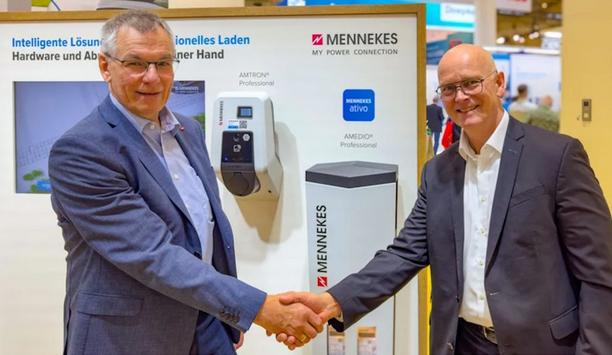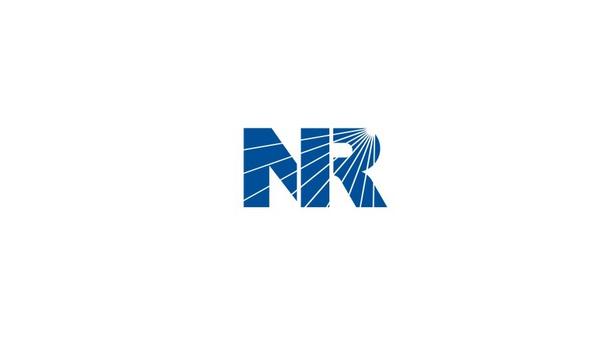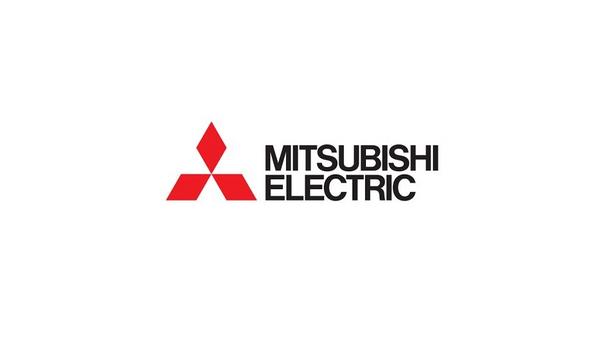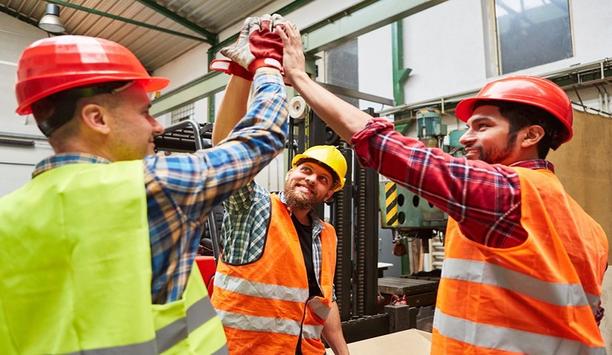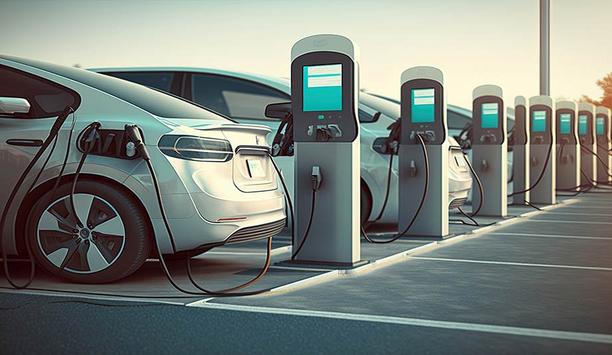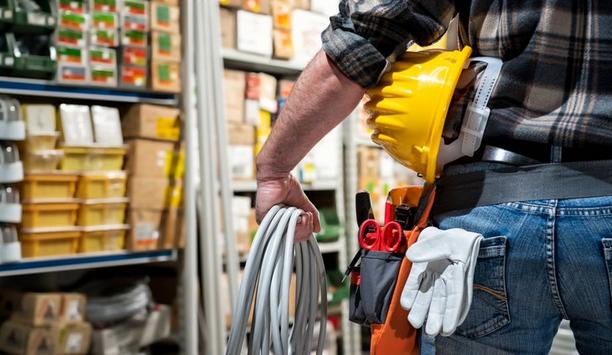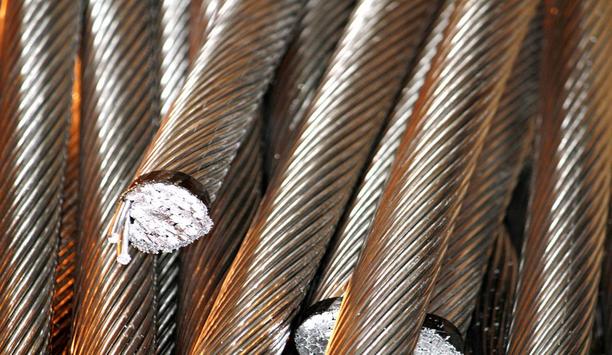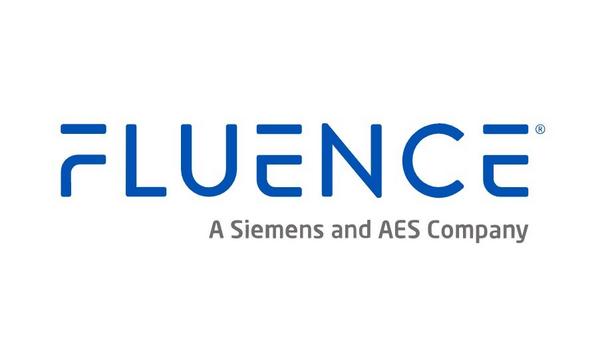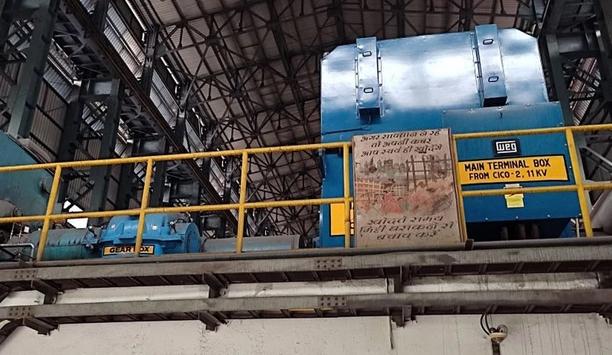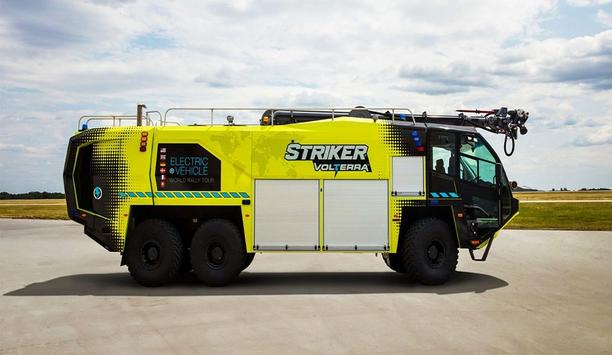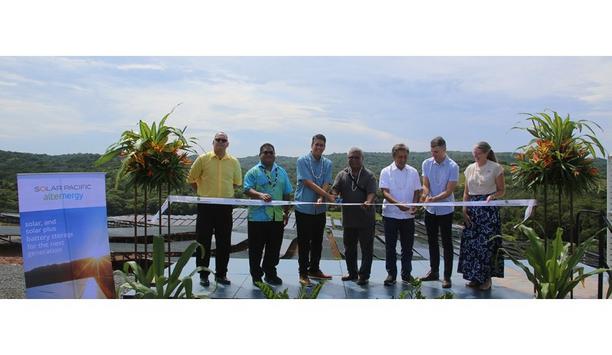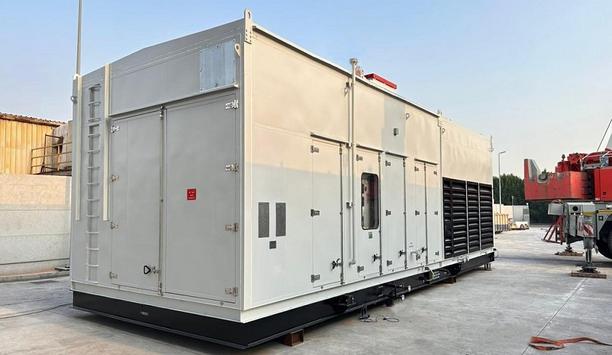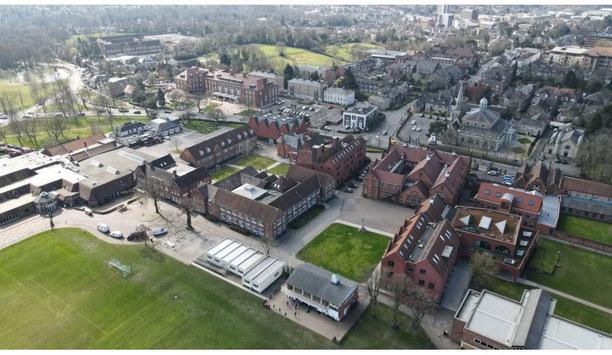Green Energy
Delta, a global pioneer in power management and smart green solutions, highlighted at Hannover Messe 2025 a versatile set of AI-driven smart manufacturing, energy infrastructure, and data centre solutions. These include, the award-winning D-Bot series cobots, featuring advanced cognitive capabilities and integration with NVIDIA Omniverse to develop next-generation digital twins; and DeltaGrid®, the AI-enabled energy management platform to optimize efficiency in the energy infrastructure sup...
Solar & Storage Live Malaysia 2025 launches in Kuala Lumpur on 9 and 10 April 2025, aimed at helping Malaysia make significant strides towards a more sustainable future and meet its renewable energy generation targets. Held at the Malaysia International Trade and Exhibition Center (MITEC), the free-to-attend expo and conference brings together thousands of industry pioneers, developers, installers, policymakers, technology experts, solution providers, investors, and innovators under one roo...
Fleet electrification provides opportunities to achieve climate goals while delivering social, financial, and environmental benefits to individuals, businesses, and communities, but the road to successful EV implementation is not without obstacles. Your EV fleets need to work — all the time under varying conditions — to ensure optimal uptime while maintaining energy efficiency. Consequently, electric vehicle service equipment (EVSE) can’t just be “tacked onto” your...
On May 30, the first 100MWp tidal photovoltaics power station in China was connected to the grid with full capacity. This is the first time that China has complementary developed solar and tidal energy. The successful grid connection of this power station marks that China has made new achievements in the field of comprehensive utilization of marine energy. NR Electric provides a complete set of protection and monitoring equipment for the project, and implements the engineering integration of 11...
On June 17, 2022, the world's first 35kV high-voltage direct coupled energy storage system developed by NR was successfully connected to the grid in Shaoxing Hongxu energy storage power station in China. It not only helps to achieve the efficient use of clean energy and promote the green and low-carbon transformation, but also enhances the flexible regulation capacity of the power grid. High voltage direct coupled energy storage not only reduces the electrical distance from the main grid, but a...
On June 8, 2022, NR controlled switching device was successfully put into operation in Fengning pumped storage power station with the largest installed capacity in the world, which successfully ensured that the pumping and storage power station units were connected to Zhangbei flexible DC power grid. This is the first application of NR's controlled switching device in a large-scale pumped storage project. Fengning pumped storage power station is a key project serving the Beijing Winter Olympics...
News
Tingshan Frequency Converter Station of Hangzhou Flexible Low Frequency Transmission Pilot Project has been officially put into operation. It is the first time in the world to realize 220kV voltage level power frequency and low frequency controllable transformation. Flexible low-frequency transmission is a new type of AC transmission technology whose frequency is lower than the power frequency, which can effectively improve the transmission capacity, distance and efficiency of transmission lines. It has certain application advantages in medium and long distance offshore wind power transmission. Low-frequency transmission technology In order to optimize the power grid layout in Hangzhou, and explore the application prospect of flexible low-frequency transmission technology in urban high-density load areas, State Grid Zhejiang Company has planned and built Hangzhou flexible low-frequency transmission Pilot project in Hangzhou. Zhejiang Company has planned and built Hangzhou flexible low-frequency transmission Pilot project in Hangzhou The two high-voltage and high-capacity frequency converter stations in Tingshan and Zhongbu constructed in the project will form flexible low-frequency interconnection, which can realize flexible power flow mutual aid and asynchronous interconnection of the two major power grids in Fuyang and the south of Xiaoshan, improve the transmission capacity and flexibility of the two major power supply sections of 500kV Fuyang substation and 500kV Shengguang substation, improve the security and stability of the regional power grid. Low-frequency transmission project Tingshan Frequency Converter Station is the first high-voltage and high-capacity low-frequency converter station in the world, and also an important part of Hangzhou flexible low-frequency transmission project. The NR project team has tailored flexible low-frequency protection & control system, frequency conversion valve, low-frequency AC protection device, measuring equipment and other core complete sets of equipment for Tingshan frequency conversion station. In view of the high voltage and large capacity application scenario of Hangzhou Flexible Low Frequency Transmission Project, the project team put forward efficient start stop control strategy, steady state control strategy, low-frequency open phase operation control strategy, fault ride through strategy, frequency converter protection strategy and low-frequency AC protection scheme, which solved many problems such as low-frequency decoupling control, bridge arm balance control, fault current suppression, low-frequency open phase operation, etc. Advance power system NR has carried out fruitful research and exploration in the field of building an advance power system At the same time, the project team overcame the problems of synchronous pressurization of converter valve at power frequency and low-frequency, completed the insulation test between high-voltage and high-capacity frequency converter valve power frequency and low-frequency terminals for the first time. To build an advance power system with renewable energy as the main body has become the main development direction of the power industry. As a key high-tech enterprise, NR has carried out fruitful research and exploration in the field of building an advance power system. Flexible low-frequency equipment The complete set of flexible low-frequency equipment developed by NR has been successfully applied to Taizhou flexible low-frequency transmission project, and continues to serve the grid connected transmission of offshore wind power in Dachen Island. Hangzhou Flexible Low Frequency Power Transmission Project is an active attempt to apply flexible low frequency complete equipment to the construction of high elastic power grids in urban areas, and also provides a practical model for high-voltage and high-capacity offshore wind power transmission through low frequency. NR will continue to maintain high standards and quality to serve the project construction, give full play to its advantages, ensure the overall operation of the project, and continue to contribute to the construction of an advance power system.
Recently, Baihetan - Zhejiang ± 800kV UHV DC transmission project (referred as "Baizhe project") has been completed, and put into operation. The BaiZhe Project is a major clean energy project to promote the energy structure adjustment, energy conservation and emission reduction. It shoulders the strategic mission of delivering the power of the world's second largest hydropower station which is Baihetan hydropower station. New power giant dragon The project starts from Jinsha River converter station in Sichuan Province and ends at Qiantang River converter station in Zhejiang Province. It passes through five provinces, with a total length of 2121 km. The Jinsha River bank and the Qiantang River bank, thousands of miles away from the two places, are integrated together with the new power giant dragon.The project starts from Jinsha River converter station and ends at Qiantang River converter station NR has provided core equipment such as DC protection & control, converter valve, measurement, stability control, compressed air foam system (CAFS), intelligent auxiliary control system, AC protection and so on for the Baizhe Project. It has cooperated efficiently in various links such as equipment development, design, production, transportation, installation and commissioning to ensure the smooth operation of the project. Intelligent auxiliary control system The new generation of DC protection & control system based on the UAPC3.0 platform has been applied for the first time in the UHV project, and the new intelligent auxiliary control system has been deployed and promoted in the UHV converter station for the first time. The response speed, reliability, operation and maintenance intelligence of the protection & control system have been further improved. For the converter valve, the four-layer valve tower structure is newly designed, which greatly reduces the volume and weight of the valve tower on the premise of ensuring the safety of the equipment. Project implementation efficiency At the same time, a number of creative improvements have been made in the aspects of type test scheme At the same time, a number of creative improvements have been made in the aspects of type test scheme, valve tower maintenance, intelligent operation and maintenance of valve control, effectively improving the project implementation efficiency and equipment safety. In terms of stability control, the new generation of PCS-992 stability control system was first applied in the UHV project, and a system scheme of independently configuring stability control equipment for the high and low end power grid at the inverter side was proposed. The software design was optimized according to the DC equipment production timing and system operation mode, realizing the adaptive strategy function, and effectively improving the adaptability and reliability of the stability control system. Improving response speed In terms of CAFS, compressed air foam spray and fire monitor redundancy design are adopted. Meanwhile, device selection is optimized to improve response speed, fire resistance measures are strengthened to improve reliability, and safe operation of converter is ensured. The smooth operation of the Baizhe project once again reflects the technical advantages of NR's multi-disciplinary integration and the ability to implement major projects with efficient cooperation, and highlights the company's outstanding comprehensive strength in the field of high-end electric equipment. In the future, NR will continue to devote itself to the construction and development of DC transmission and make greater contributions to the optimization of the energy structure and the realization of the green power application worldwide.
Ameren Illinois proposed an ambitious plan to help its residential and business customers further reduce their energy usage, lower their carbon footprint, and save on their monthly energy bills. The plan submitted to the Illinois Commerce Commission targets 1,122 GWh of electric savings through energy efficiency upgrades from 2026 to 2029, which is expected to save customers over $2 billion over the life of the upgrades. Electric and gas efficiency programs Ameren Illinois will invest $145 million per year over the next four years to deliver electric and gas efficiency programs that include residential incentives for major home upgrades, such as heating and cooling systems, air sealing, and insulation. For business customers, the program will fund advanced technologies, such as smart thermostats, variable speed drives, demand-controlled ventilation, and ductless heat pumps. Greenhouse gas emissions Additional investments will equip community-based organizations to deliver energy efficiency services Additional investments will equip community-based organizations to deliver energy efficiency services, boost job creation, and strengthen economies in downstate Illinois. Execution of the plan is also expected to lower greenhouse gas emissions in support of Illinois' Climate and Equitable Jobs Act (CEJA) goals. energy price volatility and supply shortages "This plan builds on the success of our industry-pioneering energy efficiency programs and ensures that our customers have the opportunity to benefit from the programs that they are paying for," said Lenny Singh, Chairman and President, Ameren Illinois. Lenny Singh adds, "Using energy wisely is the surest way to lower monthly energy bills. At the same time, it is a proven line of defense against energy price volatility and supply shortages, and a key tool in the fight against climate change." Ameren Illinois' energy efficiency programs Ameren Illinois' energy efficiency programs have achieved significant milestones Since 2018, Ameren Illinois' energy efficiency programs have achieved significant milestones, saving customers approximately $881 million on their electric bills. Business customers have saved over $427 million on their energy bills after utilizing program upgrades. Additionally, the program has saved more than 2.5 million MWh of electricity, which is the equivalent of removing nearly 1.7 million metric tons of CO2, removing 396,000 passenger vehicles from the road for one year, or providing electricity to more than 228,000 homes for one year. Ameren Illinois Energy Efficiency Plan Highlights of the 2026–2029 Ameren Illinois Energy Efficiency Plan: Residential Energy Savings – Ameren Illinois will invest $75 million per year in electric and gas incentives and rebates to spur adoption of energy efficient products, appliances, and equipment, and deliver home assessments to help customers uncover energy efficiency opportunities in the home. Business Energy Savings – Businesses will see a swift return on their investment for energy efficiency upgrades, typically covering costs within an average of 1.8 years. After their return on investment, these businesses will benefit from ongoing energy savings. Market Development Initiative – Ameren Illinois will invest more than $5 million per year to deliver energy efficiency benefits to underserved customers and communities. Partnerships with local community organizations will build greater community engagement, create energy industry jobs, and deliver cost savings to the customers who need it the most. Since 2018, Ameren Illinois has invested over $201 million to help reduce the energy burden of income-qualified customers. Investing in energy efficiency "Energy efficiency directly impacts our businesses in downstate Illinois because every dollar that a business saves on their energy costs can be reinvested into their processes, products, people and communities," said Kristol Simms, Vice President of clean energy transition, economic, community and business development for Ameren Illinois. Kristol Simms adds, "Businesses can count on Ameren to help them protect their bottom line. Investing in energy efficiency will lead Illinois towards a more sustainable and prosperous future." Energy demand and greenhouse gas emissions "The investment made into utility energy efficiency programs today will save energy, reduce energy bills, improve indoor air quality, and create family-sustaining jobs for the future," said Kari Ross, Midwest Energy Affordability Advocate at NRDC (Natural Resources Defense Council). Kari Ross adds, "Energy efficiency is the most cost-effective resource to reduce energy demand and greenhouse gas emissions, strengthen our power grid, and support Illinois’ climate goals for a clean energy economy."
Siemens Smart Infrastructure and Mennekes are partnering to simplify and improve power distribution planning for eMobility charging infrastructure. As part of this collaboration, Mennekes is the first partner to join the Simaris software ecosystem, giving electrical planners access to Mennekes’ industrial eMobility portfolio. Steps promoting electromobility Simaris planning tools help electrical planners dimension the electrical power distribution The Simaris planning tools help electrical planners dimension the electrical power distribution and determine the required devices such as distribution boards, making the planning of e-charging infrastructure with Mennekes charging stations simple, efficient, and seamless. This collaboration is an important step towards promoting electromobility and thereby reducing CO₂ emissions in the transport sector. "This partnership allows us to offer our customers everything from a single source for fast and easy planning of sustainable e-charging infrastructure. Together we are accelerating the energy transition," said Stephan May, CEO of Electrification and Automation, Siemens Smart Infrastructure. Electrical planning with Simaris planning tools E-charging solutions from Mennekes are simple and efficient to install. Through the partnership, the preliminary planning steps for reliable energy distribution for e-charging infrastructure are simplified. The Simaris tools enable the automatic design of all components and systems for the e-charging infrastructure, automatically considering relevant standards. Planning for eMobility infrastructure The tool creates easy-to-use planning documents and specifications for tenders, including budgeting The tool creates easy-to-use planning documents and specifications for tenders, including budgeting. Additionally, the tool provides Building Information Modeling (BIM) data for smooth data exchange, so that the planning of the charging infrastructure can be considered early in the digital twin. Projects and data from the Simaris tools can be shared, exported, and imported. "We are excited that Mennekes is the first external partner in our Simaris ecosystem, giving customers direct access to their product portfolio. This will make power distribution planning for eMobility infrastructure even simpler," said Andreas Matthé, CEO of Electrical Products, Siemens Smart Infrastructure. Charging infrastructure into Simaris Christopher Mennekes, CEO of Mennekes, said: "For years, we have been offering not just customized charging solutions, but also a wide range of services for planners." He adds, "By partnering with Siemens and integrating our charging infrastructure into Simaris, we are continuing along this path and making day-to-day work easier for planners."
Recently, the “Lishui Hydro-photovoltaic hydrogen production Biomass Near Zero Carbon Energy Pilot Project " was officially put into operation, which is the first rural hydrogen energy ecological project in China. NR has provided PCS-9150 PRO distributed control system (DCS) for this project, which can carry out the integrated and coordinated control of polymer electrolyte membrane (PEM) electrolytic hydrogen production, solid oxide fuel cell (SOFC) and methanation device, realizing the energy balance of electricity, hydrogen, heat and the safe operation of the whole station. Innovative Hydrogen Production NR refined system architecture with the customer and validated key parameters through in-plant testingIn this pilot project, technologies such as fuel cell cogeneration, PEM electrolysis hydrogen production, biogas hydrogenation and decarburization are used to achieve hydrogen production from hydropower and photovoltaic, and hydrogen purification biogas is used to synthesize biomass natural gas, so as to realize the mutual conversion of various green energies. PEM hydrogen production and SOFC are new technologies and processes. DCS has no mature control logic for reference. At the same time, the hydrogen production system also has high requirements on the reliability and rapidity of DCS. In view of the above technical problems, NR conducted multi round system architecture and scheme discussions with customer, and verified the process and key parameters through the in-plant joint commissioning test environment, ensuring the success of the project. NR DCS Achieves Milestone in Hydrogen Project After nearly a month of testing, it finally successfully completed the DCS side joint commissioning of hydrogen generation system, hydrogenation system, fuel cell and methanation, and integrated startup. DCS is stable in operation, flexible in configuration and convenient in use during the implementation of the project, and has been praised by the user. NR DCS has been widely applied to units of all capacity levels in the thermal power field, and the Lishui Hydrophotovoltaic hydrogen production Biomass Near Zero Carbon Pilot Project is a breakthrough in the new application field of NR DCS system. Advancing Hydrogen Control Hydrogen energy will occupy a very important position in future energy pattern. NR will make use of the technical reserve of multi-specialty integration, deeply cultivate hydrogen related control and protection technologies, give play to the advantages of integrated secondary products, and provide a more stable and reliable overall solution for hydrogen energy secondary integration.
Mitsubishi Electric Corporation announced that it has signed an agreement with HD Renewable Energy Co., Ltd., a Taipei-based developer and operator of solar power and battery storage systems, to collaborate on initiatives that will help realize carbon neutrality. As part of their collaboration, the companies will establish an aggregation business joint venture and Mitsubishi Electric will acquire a stake in HD Renewable Energy. Profitability of power generation Amid rising fuel costs and global efforts to realize carbon neutrality, Japan is actively promoting the adoption of renewable energy. However, owing to fluctuations in power generation from renewable sources such as solar and wind resulting from their dependence on seasons, weather, and time of day, transmission system operators are required to continuously monitor the demand for power and fine-tune adjust supply and demand. Against this backdrop, there is an expansion in the aggregation market, where multiple distributed energy resources (DERs), such as renewable energy generation facilities and battery storage systems, are utilized to help stabilize power grids and maximize the profitability of power generation and storage businesses.


Expert Commentary
While the technology sector was once considered the most desirable in terms of salary and job security, recent layoffs have exposed its vulnerability. Job security has always been a sought-after job benefit, and one career path that’s often overlooked is skilled trades. The skilled trades industry stands out as a resilient sector, offering the next generation of workers a promising path for growth and professional development through on-the-job experience and education. Significant talent gap With the retirement of Baby Boomers leading to a significant talent gap, current trade professionals are now more determined than ever to attract younger workers to the industry. Regrettably, many students in high school fail to see the value of pursuing a career in skilled trades. In a 2022 survey, only 16% of students noted they were likely to consider a career in the skilled trades. However, as other industries face a high level of uncertainty, the skilled trades offer stability and constant demand for services such as new construction, renovations, and climate change-resilient building improvements. The Benefit of Trade Education One of the major benefits of skilled trades education is its flexibility and room for career advancement The skilled trades industry presents young professionals with unique opportunities for hands-on learning and digital skill development. And as the next generation begins to explore higher education alternatives to gain valuable life skills, hands-on training in skilled trades becomes increasingly appealing. In trade education, learning happens directly from experiences in the field, complemented by classroom training, on-demand video sessions, and even virtual reality (VR) simulations. This approach ensures that graduates are well-prepared to start their careers immediately, avoiding the burden of college debt. One of the major benefits of skilled trades education is its flexibility and room for career advancement. Unlike traditional four-year college programs, trade school education typically lasts around two years, making it accessible to individuals at different stages of their careers. Moreover, the skilled trades industry provides workers with continuous opportunities for education and specialization. Formal certifications or licensing requirements define career paths in the skilled trades, and workers can pursue additional certifications to open new avenues for advancement. Beyond Traditional Training Techniques To maintain its resilience, the skilled trades industry is embracing technology To maintain its resilience, the skilled trades industry is embracing technology, integrating tech-focused learning methods and digital platforms to streamline processes and increase efficiency. Gen Z is inherently tech-savvy, and incorporating new technologies in training and in the field will attract these younger generations to the industry. This can include implementing tech-focused learning methods, embracing gamification, or transitioning from physical code books to digital platforms to streamline processes, make work more efficient, and increase engagement on new tools coming onto the jobsite. While the skilled trades industry offers numerous opportunities for growth and professional development, it is essential to acknowledge that these professions are not without their risks. Enhancing safety training Skilled trade workers, particularly those in fields like construction, electrical work, and fire safety, are often exposed to serious fire, electrical, and related hazards on the job. Ensuring the safety of these workers is of paramount importance. One powerful solution to enhance safety training is the integration of digital learning technology One powerful solution to enhance safety training is the integration of digital learning technology, which is uniquely suited to provide deep immersion simulations. By incorporating virtual reality (VR) and augmented reality (AR) training modules, skilled workers can experience lifelike scenarios that simulate potential hazards in a controlled environment. This kind of training allows them to develop critical skills, practice emergency response procedures, and make informed decisions without facing real-life risks. By leveraging digital learning technology, the skilled trades industry can better equip its workers with the knowledge and experience needed to enhance job safety and minimize workplace accidents. The Bottom Line The skilled trades industry presents a promising future for the next generation of talent. It offers resilience in the face of economic fluctuations and provides abundant opportunities for growth and professional development through hands-on training. To attract a new generation to this industry, organizations must be willing to not only emphasize value, in terms of resiliency salary, to candidates, but also show that the industry is moving towards innovation just like any other profession. As the industry continues to embrace technology, such as digital learning, it will remain relevant and appealing to young, technologically adept individuals seeking rewarding and stable careers. And by showcasing the value and potential of skilled trades, we as skilled trades professionals can inspire more individuals to consider this path and take the first step toward a successful and fulfilling career.
The promise of electric vehicles is closer to reality than ever before. New plans and investments at the federal level designate billions of dollars to move our country toward clean energy, including $2 million to help auto manufacturers retool facilities to increase EV production. Additionally, the Biden Administration has announced a goal to create 100% carbon-free electricity by 2035 and a net-zero carbon economy by 2050. Domestic EV marketplace The domestic EV marketplace has grown from 16,000 to more than 2 million vehicles in the last decade and is poised to expand at lightning speed over the next ten years. S&P Global mobility has predicted that by 2030, electric vehicles (EVs) will make up 40% of the U.S. market share of new vehicles on the road. This dramatic increase in EVs will require a nationwide network of charging stations to meet the demand from the current 140,000 to over 1.1 million. Charging stations It is a necessity that regulators lay the groundwork now for a reliable and secure charging networkThe expansion of charging stations will undoubtedly give zero-emissions drivers more confidence in their ability to refuel more conveniently. Still, it’s critical that confidence in infrastructure security also be prioritized alongside this growth. If not adequately protected and monitored, charging stations could serve as access points for cybercriminals, potentially leading to personal data leaks, attacks on vehicle systems, and even widespread blackouts. As EVs continue to gain momentum as realistic alternatives to CO-2 emitting vehicles, it is a necessity that developers and regulators lay the groundwork now for a reliable and secure charging network for the long term. EV Charging Infrastructure and the electric grid The nation’s electric grid generates and delivers electricity essential to everyday life. It’s made up of power plants and other sources of generated electricity, complete with transmission and distribution lines and infrastructure that delivers essential power. Grid connection An important aspect to remember about EV charging stations is that they connect to their relative electric grid. Simply put, the infrastructure for charging stations is comprised of devices that wait for another device to connect and communicate. However, it lacks a third-party firewall or other devices that can act as protection. Unfortunately, this results in vulnerability and means new doors for cybercriminals to walk through. Cybersecurity risks If the grid became compromised by a large-scale attack, it could lead to destructive and widespread blackouts Even before EV charging stations are factored in, the electric grid faces substantial cybersecurity risks from criminals, terrorists, hackers, and foreign governments every day. If the grid became compromised by a large-scale attack, it could lead to destructive and widespread blackouts that would undoubtedly affect EV charging stations and other essential institutions such as banks, hospitals, and gas stations. With the expansion of EV charging stations, the risks only grow. Now is the time to address threats and strategize before disaster strikes. Risks of connectivity emerge The world we live in has reached a level of being almost entirely connected at all times – security systems, appliances, health monitors, industrial sensors, and now, our vehicles. While the connectivity of vehicles has been incredibly beneficial to consumers and the automotive industry alike, the growth in the internet of things (IoT) has opened countless doorways for cybersecurity threats. Software flaws One young information technology security specialist reported finding flaws within a third-party software that a handful of leading EV manufacturers use. It gave him access to more than 25 EVs in at least 13 countries. The man, who stumbled on the findings in 2022, said he could remotely control some EV functions, including starting vehicles, unlocking windows and doors, disabling security systems, and turning on stereo systems and flashing headlights. The IT specialist said he could also tell if a person was in the vehicle. In a separate and concerning situation, a single compromised password led to a foreign-fronted cyberattack on a U.S.-based pipeline in 2021. It halted the fuel supply process on the east coast and cost the company $4.4 million in ransom money. Cyberattacks Thousands of charging stations are already in danger of being targeted by cybercriminals The point is that even massive and powerful companies can fall victim to cyberattacks. Even though cybersecurity is a critical issue for EV manufacturers, their systems are still vulnerable to hackers. Thousands of charging stations are already in danger of being targeted by cybercriminals, and as the number of stations grows, so too will the risk. The higher the number of entry points, the more opportunities hackers will see. If they can break into and gain access to even the most sophisticated EVs, it could be catastrophic. Ensuring security and reliability through proactivity Because charging stations are connected to the country’s primary grid, the entire infrastructure must be armed with the most aggressive security measures. The risks associated with modernized electric vehicles are not something that traditional automotive safety regulations and security standards properly cover. The complicated and rapid evolution of EVs is putting them at a heightened threat. When charging stations are connected to the electrical grid, it is imperative to ensure strong cybersecurity measures are in place to remain dependable and effective. Embedding cybersecurity technology We often see outside parties utilized to secure tech because of the frequent lack of necessary cyber protection The best way to ensure the electric grid's safety is to build cybersecurity technology directly into the charging stations. We often see outside parties utilized to secure tech because of the frequent lack of necessary cyber protection. Unfortunately, the promising growth EVs and their charging stations bring to our environment also contributes to technology’s vulnerabilities, which can cause key security measures to be overlooked. There’s no getting around it: EV charging stations are highly vulnerable to hackers. Awareness and solutions As the growth continues, there is an acute need for heightened awareness and solutions for the weaknesses associated with these charging stations. These solutions should consider everything from the charging points and devices to operators of the energy distribution networks and infrastructure providers. We must aim to implement advanced cybersecurity measures that will keep safe drivers and all the data that EVs contain.
Power Beat
Packaging materials help to protect fragile electronics and electrical components from breakage. Small electrical devices and electronics are often packaged in individual plastic coverings within a larger box. Manufacturers use a variety of plastics to produce anti-static bags, pouches, film, and bubble wrap for electronics. single-use plastics Excessive consumption of single-use plastics and other packaging materials is an emerging concern in the electrical market. The use of plastic and non-recyclable materials in equipment packaging is contributing to the electrical market’s environmental footprint. organic packaging More electrical manufacturers need to transition towards a more sustainable future and implement organic packaging. Companies can minimize the negative environmental impact and become more green-friendly. While the industry has previously had a negative environmental impact, many businesses are rectifying these issues. Using less paper, plastic, wood, metal packaging, and other auxiliary materials contributes to the goal of being lightweight, recyclable, and sustainable. polystyrene foam Of the total plastic packaging waste, around 40% is disposed of at sanitary landfills Many electrical components are packaged with plastic shrink films. In addition, polystyrene foam can be used to cushion components, and plastic corner protectors may be used to strengthen boxes. Less than 10% of the plastic waste ever generated has been recycled. Plastics pollute the ocean and do not decompose in landfills. Of the total plastic packaging waste, around 40% is disposed of at sanitary landfills, 14% is collected for recycling, and 14% makes its way to incineration facilities (which cause CO2 emissions). The negative impact of plastic The fact is, most plastics used for packaging are recyclable, although most wind up in landfills due to ineffective or non-existent packaging recovery schemes. In addition, plastics contribute to emissions of greenhouse gas at each stage of their lifecycles. Therefore, plastics, which contribute up to 13% of the total “carbon budget,” will negatively impact efforts to meet the Paris climate agreement. action against single-use plastics There is a shift in focus from consumer education to holding manufacturers responsible for their environmental impact Focusing on consumer behavior has spurred much of the campaign against plastics to date. For example, the federal government has taken steps to phase out single-use plastics in national parks and other public lands. Several states have taken action against single-use plastics. For example, New Jersey no longer allows grocery stores and retailers to distribute plastic bags. The Garden State has also banned polystyrene foam packaging from restaurants and food companies. However, there is also a shift in focus from consumer education to holding manufacturers responsible for their environmental impact. Maine and California are focusing on the issue and may be among the jurisdictions to target manufacturers’ role in single-use plastics. replacement alternatives There are replacement alternatives available, but they tend to add costs for manufacturers. For example, bioplastics are made with biodegradable sources that can break down faster than traditional plastics. However, bioplastics must be properly disposed of through composting to break down. Also, bioplastics are not recyclable and can even contaminate other recyclable materials. Disposal in a landfill, which is common, defeats the purpose of using more expensive materials. environmentally friendly alternatives Some argue that recycled plastic may be the greenest alternative, although it results in recyclables winding up in landfills Instead of polystyrene foam, packaging may consist of corrugated cardboard or plastic alternatives that are allegedly more environmentally friendly. Biodegradable wood or paper are other alternatives. However, disposal in landfills continues to be problematic with decomposition sometimes leading to the production of methane (a greenhouse gas). However, some argue that recycled plastic may be the greenest alternative, although recycling realities instead result in recyclables winding up in landfills, where they do not decompose. EPR schemes An added cost for electrical manufacturers might be a requirement to pay into extended producer responsibility (EPR) schemes. EPR is a strategy to add the estimated environmental costs associated with a product’s entire lifecycle to the cost of the product. In effect, the strategy assigns responsibility for the environmental impact of products to the manufacturer. Legislation Legislation to address packaging EPR has been implemented in Maryland, New York, Washington, and New Jersey (originally introduced in 2022 and still active). In 2016, the Product Stewardship Institute developed a model packaging EPR legislation, then updated it in 2019 with input from the industry and government. Maine and Oregon used the model to enact packaging EPR laws in 2021, Colorado followed suit in 2022 and, that same year, California also enacted legislation that the model informed.
The electrical industry is expected to have a labor shortage of about 60,000 workers by 2026. A labor shortage in the electrical trade is not inevitable, but it is likely to continue if the industry does not take steps to address the issue. Like other skilled trades, the electrical industry is facing challenges that could contribute to a labor shortage, including an aging workforce, a lack of interest among younger generations, and competition from other industries. However, there are strategies the industry can implement to address these challenges and attract a new generation of workers. These strategies include increasing awareness of the benefits and opportunities of skilled trades, investing in training and education programs, improving working conditions and compensation, embracing technology, promoting diversity and inclusivity, and collaborating among industry, education, and government. Improving working conditions Factors in the current labor shortage in the electrical industry include: Aging workforce: Many workers in the electrical industry are nearing retirement age, and there are not enough younger workers to replace them. This has led to a shortage of skilled workers with many years of experience in the industry. Lack of interest in the trades: There has been a decline in the number of young people pursuing careers in the skilled trades, including electrical work. This is due in part to a focus on four-year college degrees as the preferred career path, as well as a lack of awareness of the benefits and opportunities of skilled trades. Competition from other industries: The electrical industry is competing with other industries, such as construction and manufacturing, for skilled workers. Training and education: Training and education are critical for developing the skills and knowledge necessary for electrical work. However, there is a shortage of qualified trainers and educators. Increasing demand: The demand for electrical services is increasing, particularly in areas such as renewable energy and smart grid technology. Attracting and retaining workers To attract and retain workers, the electrical industry must offer competitive wages and benefits One strategy to address the labor shortage is to increase awareness of skilled trades and to promote the benefits of a career in the electrical industry through outreach programs in schools, career fairs, and other events. Providing access to quality training and education programs that develop the skills and knowledge necessary for electrical work is crucial for attracting and retaining workers. This can be done through apprenticeship programs, vocational schools, and community colleges. To attract and retain workers, the electrical industry must offer competitive wages and benefits, as well as a safe and supportive work environment. This includes offering training and development opportunities, flexible schedules, and opportunities for advancement. Inclusive work environment The electrical industry is changing rapidly, and workers must be equipped with the latest technology and tools to stay competitive. Providing workers with training and access to the latest technology can help attract and retain workers. The electrical industry should actively promote diversity and inclusivity to attract a wider pool of workers. This includes efforts to recruit workers from underrepresented groups and create a welcoming and inclusive work environment. The electrical industry is changing rapidly, and workers must be equipped with the latest technology Companies in the electrical industry are addressing the labor shortage problem by investing in workforce development programs and initiatives. For example, Schneider Electric has developed a comprehensive workforce development program called the Schneider Electric Energy and Automation Training (SEAT) program. The SEAT program provides training and certification for employees, customers, and partners in areas such as energy management, automation, and digital transformation. Developing training programs Siemens has developed several initiatives to address the labor shortage in the electrical industry. These initiatives include apprenticeship programs, vocational training programs, and partnerships with educational institutions to develop training programs. Graybar, a distributor of electrical products and solutions, has developed a workforce development program called Graybar University to provide training and education for employees, customers, and partners in areas such as lighting, automation, and safety. Joint apprenticeship training program Collaboration among industry, education, and government is crucial for developing solutions The International Brotherhood of Electrical Workers (IBEW) and the National Electrical Contractors Association (NECA) have developed a joint apprenticeship training program that provides training and education for individuals looking to enter the electrical industry. The program provides on-the-job training and education in areas such as electrical theory, safety, and installation. Collaboration among industry, education, and government is crucial for developing solutions to the labor shortage in the electrical industry. This includes partnerships between industry and education institutions to provide training and education programs, as well as government initiatives to support workforce development in the skilled trades.
As our transition to greener energy grows, so does the demand for copper, the highly conductive material at the heart of electrical applications. Copper is spooled up inside electric engines, concealed inside the walls of buildings, and stretched along city streets to transmit power from one point to another. Copper substitutes As demand for electric devices grows, copper supplies are strained, and prices increase. A substitute for copper with similar conductive properties would be especially useful in our environmentally enlightened future. Other metals, including aluminum, are used to conduct electricity in some applications, but aluminum is only 60% as conductive as copper. Scientists have undertaken the task of increasing the conductivity of aluminum to make it viable as a substitute for copper. It would be a game-changer if they are successful, given that aluminum is 1,000 times more abundant than copper on the earth’s surface. Aluminum is also lighter, cheaper, and easier to mine. Developing ultra-conductive aluminum By altering the structure of the metal and introducing the right additives, conductivity properties can be improved At the Pacific Northwest National Laboratory (PNNL), scientists work to address the pressing challenges we face in the future through chemistry. One of those challenges is to develop an ultra-conductive aluminum alternative to copper. PNNL researchers evaluated the effects of temperature and structural defects on aluminum conductivity, seeking a “recipe” to increase its conductivity. By altering the structure of the metal and introducing the right additives, conductivity properties can be improved. molecular simulation Using molecular simulation, the researchers replicated what would happen to aluminum’s conductivity if individual atoms were removed or rearranged. Even small changes can boost conductivity. The computer models proved themselves well-suited to simulate real-world conditions. Having settled on a recipe to boost the conductivity of aluminum, researchers will now test the theory in the laboratory. Aluminum alloys made using additives such as graphene or carbon nanotubes can also provide properties material that pushes the metal past its theoretical limit of conductivity. Solid-phase manufacturing enables the layering of new carbon materials into the metal to improve conductivity. Conductivity testing Producing wires out of the alloys will allow researchers to test conductivity. Then creating bars and sheets will enable testing to determine if the material is strong and flexible enough to be used for industrial applications. If testing is successful, researchers will work with manufacturers to produce higher amounts of the alloy. The research comes at an opportune time: The price of copper has spiked, and analysts project a shortage. Green energy transition The availability of more conductive aluminum will open a wider range of electrical applications The transition to green energy will increase the demand for conductive materials in applications like offshore wind farms. An electric vehicle uses about four times as much copper as a conventional car. Aluminum is already used for high-voltage power transmission because it is lightweight and inexpensive. However, the current applications for aluminum are limited by its lower power conductivity compared to copper. The availability of more conductive aluminum will open a wider range of electrical applications. ultra-conductive aluminum applications In the end, ultra-conductive aluminum would be useful as an alternative to copper in transmission lines, vehicles, electronics, and the power grid. Founded in 1965, PNNL is operated by Battelle for the Department of Energy’s Office of Science, which is the largest supporter of basic research in the physical sciences in the United States.
Case studies
Fluence Energy, Inc., a global provider of energy storage products, services, and optimization software for renewables and storage, announces that the company has been selected by Origin Energy Limited (Origin) to deliver a 300 MW / 650 MWh battery at the Mortlake Power Station in southwest Victoria. The project will use Fluence’s Gridstack™ energy storage product with a 15-year service agreement contributing to Origin’s strategy to accelerate renewable energy and energy storage in its portfolio. The system will also utilize Fluence’s AI-powered asset performance management (APM) software, Nispera™, to optimize the battery’s operational performance. Energy storage projects The system will capture excess power during periods of high renewable generation “We are honored to be selected by Origin to deliver this grid-forming battery-based energy storage system and deploy our ecosystem of solutions,” said Fluence President and Chief Executive Officer, Julian Nebreda. Julian Nebreda adds, “Australia is an important market for Fluence. Our local team is now delivering over 1 GW energy storage projects within Australia to enhance grid stability and enable the country’s clean energy transition.” Energy storage system to be commissioned in late 2026 The site preparation and civil works of the Mortlake Battery are expected to commence following a period of detailed design and procurement activity. The energy storage system is anticipated to be commissioned in late 2026. Located in Victoria’s South West Renewable Energy Zone, this energy storage system will provide system strength to the grid. The system will capture excess power during periods of high renewable generation and discharge to meet peak demand.
WEG stands out once again by supplying a large custom-built induction motor for an Integrated Steel Plant in the Eastern part of India, in the state of Odisha. The induction motor of the MGW line, 26 MW/4 Poles/11 kV, is the largest ever manufactured in WEG's manufacturing site in India for the Indian market, it was selected to drive the main air compressor of the oxygen plant, essential for the operation of the entire Phase-1 of the steel production plant. challenges of interchangeability The project involved replacing an existing motor at the plant, a complex task that required technical expertise to overcome the challenges of interchangeability of the new motor with the existing structure. For this, it was essential to combine all the dimensions of the machine, ensuring that no modifications were necessary on-site or in the foundation. From the water inlet and outlet to the oil lines, cable entry points and shaft details, each element was carefully considered for an efficient transition. WEG supplies induction motor System criticality has been significantly minimized, eliminating the need for complex maintenance The choice of an induction motor not only met the technical demands, but also offered substantial advantages over synchronous motors, commonly used for this application because induction motors are rare in this size and power. System criticality has been significantly minimized, eliminating the need for complex maintenance associated with components such as the exciter and exciter panels, as well as delicate integration with motor and rotor telemetry systems. WEG's commitment The reliability of WEG's induction motor was a key element in keeping production running smoothly. Since the motor was installed, the steel plant has not experienced any unplanned downtime in the last one year of operation, contributing to a continuous and efficient production environment. With WEG's commitment to offer technological and reliable solutions to the market, this association not only increases the productivity of the plant, but also contributes to increasing the steel production capacity on Indian soil.
Oshkosh Airport Products, a division of Pierce Manufacturing Inc., a subsidiary of Oshkosh Corporation announces Airservices Australia has issued a purchase order for four Oshkosh Airport Products Striker® Volterra™ 6x6 Aircraft Rescue and Fire Fighting (ARFF) hybrid electric vehicles. These environmentally advanced fire apparatus will be deployed at the new Western Sydney International Airport (WSI), set to open in 2026. Striker Volterra 6x6 The Striker Volterra 6x6 comes equipped with an Oshkosh-patented hybrid-electric drivetrain, featuring an electro-mechanical infinitely variable transmission. This enables zero-emissions operation through the integrated onboard batteries and uninterrupted power supply by coupling with the internal combustion engine for pumping and drive systems. innovative design Airservices Australia is making a significant investment to support the development of an “airport of the future” WSI is a transformational infrastructure project expected to boost economic activity, provide local employment opportunities, meet Sydney's carbon-neutral sustainability initiatives, and meet the area’s growing aviation needs. Airservices Australia is a government entity making a significant investment to support the development of an “airport of the future,” featuring world-pioneering technology, innovative design, and a sustainability plan incorporating assets like the Striker Volterra ARFF hybrid electric vehicles. sustainability "As the first airport built in Australia in over 50 years, WSI is not just an airport; it's a statement of intent for a more sustainable future,” said Dave Archer, Vice President of Engineering for Oshkosh Vocational. He adds, “The Striker Volterra vehicles, with their hybrid electric technology, align perfectly with Airservices Australia and WSI’s goals. These vehicles are not only an asset to emergency response capabilities but also play a crucial role in larger environmental sustainability initiatives." environmentally conscious choice Dave Archer continues, "They symbolize a dedication to intelligent design, energy optimization, fire crew safety and efficiency, and ultimately, a carbon-neutral future." Striker Volterra ARFF hybrid electric vehicles demonstrate the most advanced acceleration and reduced fuel consumption compared to our standard diesel models, making them an environmentally conscious choice for emergency response services. Striker Volterra features Striker Volterra ARFF demonstrates a 28 percent improved acceleration compared to the standard diesel models WSI’s four new Striker Volterra 6x6 vehicles will feature an industry-pioneering modular cab design, TAK-4® all-wheel independent suspension, and a 50’ Snozzle® High Reach Extendable Turret. They each house an 11,356-liter (3,000-gallon) water tank, a 1,590-liter (420-gallon) foam tank, and a 7,570 lpm (2,000 gpm) water pump, along with a 250 kg (550 lb.) dry chemical powder system. Accelerating from 0 to 80 kph (0 to 50 mph) in under 25 seconds, the Striker Volterra ARFF demonstrates a 28 percent improved acceleration compared to the standard diesel models when fully loaded. training, implementation, and service support Dave Archer added, “The collaboration between Oshkosh Airport Products and Airservices Australia marks a significant step forward in the aviation industry's commitment to sustainability. We remain committed to a strong partnership, providing world-class training, seamless implementation, and unwavering service support to ensure these vehicles exceed expectations in the critical missions of ARFF crews.” By leveraging new technologies and innovations like Oshkosh Airport Products’ Striker Volterra ARFF hybrid electric vehicles, WSI will showcase the feasibility of low-carbon operations and set a new standard for airports worldwide.
DNV is pleased to have supported a landmark solar and storage project in the Republic of Palau in the Western Pacific region. Philippines-based power producer - Solar Pacific Energy Corporation (SPEC), the solar developer of listed Alternergy Holdings Corporation, appointed DNV as Owner’s Engineer for the 15.3 MWp solar power and associated 13.2 MWh battery energy storage system (BESS) in Ngatpang state on Babeldoab, the largest island in the Palau archipelago. The USD 29 million project, which is jointly owned by SPEC and its listed parent – Alternergy, will meet more than 20% of Palau’s energy needs. SPEC was awarded a long-term power supply agreement by the Palau Public Utilities Corporation (PPUC) to feed power to the central grid in Badelboab. The power plant was inaugurated last June 2. DNV’s work scope for the solar + BESS hybrid system DNV assessed if the design would meet two main purposes: grid smoothing and energy generation DNV’s work scope for the solar + BESS hybrid system, SPEC’s first venture into overseas markets, spanned four phases across the design, pre-construction, construction, and project completion stages. DNV assessed if the design would meet two main purposes: grid smoothing and energy generation. It advised on project scheduling and progress tracking, and checked the engineering, procurement and construction (EPC) contract on SPEC’s behalf. “Solar Pacific is grateful to DNV for its excellent technical and project management support throughout the pre-construction and implementation stages of this exciting project. DNV provided valuable expertise to ensure the delivery of a rather complex project that involved a PV and battery storage hybrid solution on a challenging project site located in a remote location. We look forward to expanding our working relationship with DNV throughout the Asia Pacific region,” said Mike Lichtenfeld, the Chief Executive Officer (CEO) of Solar Pacific Energy Corporation (SPEC). DNV, Alternergy and SPEC partnership “Alternergy is delighted to conclude another successful renewable project with DNV,” said Gerry Magbanua, the President of Alternergy, adding “Since 2014, we have collaborated with DNV in developing our pioneering wind and solar projects in the Philippines.” Project construction management was conducted remotely from DNV’s Singapore office Project construction management was conducted remotely from DNV’s Singapore office, with DNV’s partner providing onsite construction personnel supervised and managed by DNV and owner’s site representatives (OSRs) for both the civil and electrical engineering aspects. The OSRs monitored construction and with input from DNV specialist engineers, delivered several monitoring, inspection, verification, witnessing and testing activities during construction, commissioning, testing and energization of the system. DNV inspections post-commissioning DNV inspections post-commissioning ensured that non-conformance with contract specifications was sufficiently rectified, before certifying the project as ready for handover and issuing the Final Completion Certification. According to DNV’s latest Energy Transition Outlook report, Southeast Asia will see solar PV and solar coupled with storage play a significant role in the region’s electricity generation share, rising sharply from the late 2030s to generating 74% of the electricity by 2050.
Located on the Red Sea coast of Saudi Arabia, Yanbu is the nerve center of the Kingdom’s petrochemicals industry. One of Yanbu’s critical installations is the power station, which has several Gas Turbine Generators (GTGs) with a total capacity of 524.6MW. The power station caters to the region’s total electricity demand. DG sets In case of any unexpected shutdown, the GTGs are restarted by DG sets designed specifically for Black Start applications. The DG sets are supplied by Saudi Diesel Equipment Co. Ltd., a well-known local manufacturer, and supplier to the oil and gas industry since 1978s. The new DG sets are supplied to replace a 35 years-old existing DG sets based on a detailed assessment by the company responsible for the maintenance of the power station. Entrusted with the task, Saudi Diesel opted for alternators from Nidec Leroy- Somer, its trusted supplier. DOL starter motors Given the critical nature of the project, the company ordered two DG sets for redundancy and reliability The GTGs are equipped with DOL starter motors of 600kW, 4.16kV rating, and the starting current is very high, 6 times the nominal current which means there is a huge inrush current experienced by the alternator. Given the critical nature of the project, the company ordered two DG sets for redundancy, and thereby, reliability. Black Start The DG set first acts as a Black Start and is primarily responsible to start the turbines that are down or under planned maintenance shutdown. The DG set is also used to feed auxiliary loads in case the need arises for emergency loads other than the turbine load, before or after the Black Start, till such time the turbines take over the full load. Challenge For Nidec Leroy- Somer, the challenge was to design a medium voltage 4.16kV alternator with a rated power of 4000kVA. This is a high-speed alternator, IP23 rated, so there were some constraints regarding the design of the machine. An important consideration was adapting the design to the ambient temperature of 50°C with the humidity reaching 100% in consideration of the very harsh environment at the site. D550 digital AVR AVR has functionalities including online monitoring with manual and remote controls Nidec Leroy- Somer also used the latest D550 digital AVR, which is ideal for parallel genset operation. The AVR also has a wide range of functionalities including online monitoring with manual and remote controls. The two alternators were designed and manufactured after a thorough calculation of all electrical parameters following detailed discussions with the client before finalizing the design. Once assembled, the alternators were tested and approved by Saudi Diesel along with third-party inspectors, a prerequisite for any machine exported to Saudi Arabia. synchronous speed “Any application that involves a power plant is very critical, because in case of a shutdown, the unit has to restart and come online as fast as possible, and these are very heavy turbines, each of 50MW. Also, they must run to a synchronous speed before energizing the equipment and connecting to the grid. That is the critical part, getting the GTGs into a synchronous speed before connecting to the grid,” says Nawar Shubber, Regional Sales Manager at Nidec Leroy-Somer. complete packaged units The two DG sets were supplied as complete packaged units, each measuring 13mtr (L) x 5mtr (W) x 6 meters (H) in dimensions. The diesel engine is from MTU, Germany. Each package is a complete unit with the Engine coupled to the Alternator, Diesel Tank, MV Switchgear, 480V Motor Control Center (MCC), Control Panel, Fire Alarm, Suppression System, and Radiator Cooling System. axial up-blast fans Two axial up-blast fans have been installed for ventilation purposes during operation to maintain the temperature rise inside the enclosure within 5-degC. The ingress protection rating during standby time for the whole package is IP56. The packages are based on a plug-and-play concept easy to install, easy to run, and easy to maintain. gas-tight enclosure Enclosures for the entire generator set, fabricated locally, contain UL-motorized louvers" “Enclosures for the entire generator set, fabricated locally, contain UL- motorized louvers for totally enclosed operation during shut-down. The package is designed as a gas-tight enclosure while the fire alarm and suppression systems in these units are tested by NFPA 2001 and BS EN 15004-1,” says Kathim Alrifai, Project Manager at Saudi Diesel Equipment Company. generator Apart from the harsh environment, the project is also located within a high seismic zone. The generator is mounted on dual spring and rubber vibration isolators designed to withstand earthquakes and seismic activity within specific limits, as determined by the data applicable to the city.
Brentwood Borough Council has recognized the need for change on life safety products within their housing stock. After discussions on Smart Social Housing with Carol Burton, Interim Corporate Manager – Technical Services, they are pleased to announce a new trial to see 40 properties fitted with Aico heat, smoke and CO alarms, HomeLINK Gateways and Environmental Sensors throughout the borough. The scheme will update the home life safety systems, to comply with British Standard BS5839-6 and BS50292. These houses will be handpicked for a variety of reasons and monitored on their performance before, during and after any changes have been made to improve the quality of life for the residents involved. Brentwood Borough Council to implement Aico’s HomeLINK Due to the ability to remote manage these systems it will save the local authority valuable time By implementing Aico’s HomeLINK Connected Home Solution, Brentwood Borough Council will have the ability to link every alarm in a property to the HomeLINK portal, producing the collated data in an easy-to-read report. These actionable insights will enable preventative measures and proactive maintenance of connected fire alarm systems. Due to the ability to remote manage these systems it will save the local authority valuable time, a reduction in call out costs and offer a greater duty of care to their residents. Aico’s HomeLINK Connected Home Solution deployed The scheme will put Brentwood Borough Council at the forefront of tenant safety, leading with Aico’s innovative and reliable products. Aico will be working with the council through the whole process and offering training and support continuously so the full potential of this scheme can be achieved. Carol Burton, Interim Corporate Manager – Technical Services said “Brentwood Borough Council are looking forward to working with Aico. Installing the Homelink Gateway and Environmental Sensors will complement the fire and carbon monoxide alarms we have already installed.” Smart home technology Carol Burton adds, “This modern technology will empower our tenants to see in real time how their home is performing and will help Brentwood Council identify properties that are most at risk, enabling proactive measures and preventative maintenance of our assets.” Aico ‘s Regional Specification Manager, Matt Golding states “It’s great to be working with such a proactive and keen Council who have embraced the concept straight away and can see the benefits of the Aico Homelink system, not only making them more effective in their housing management, but also supporting the health and well-being of their tenants.” Matt Golding adds, “We will work closely together to ensure the right advice and training is supplied and engage with the residents to let them know fully how this can benefit the environment they live in.”


Products


